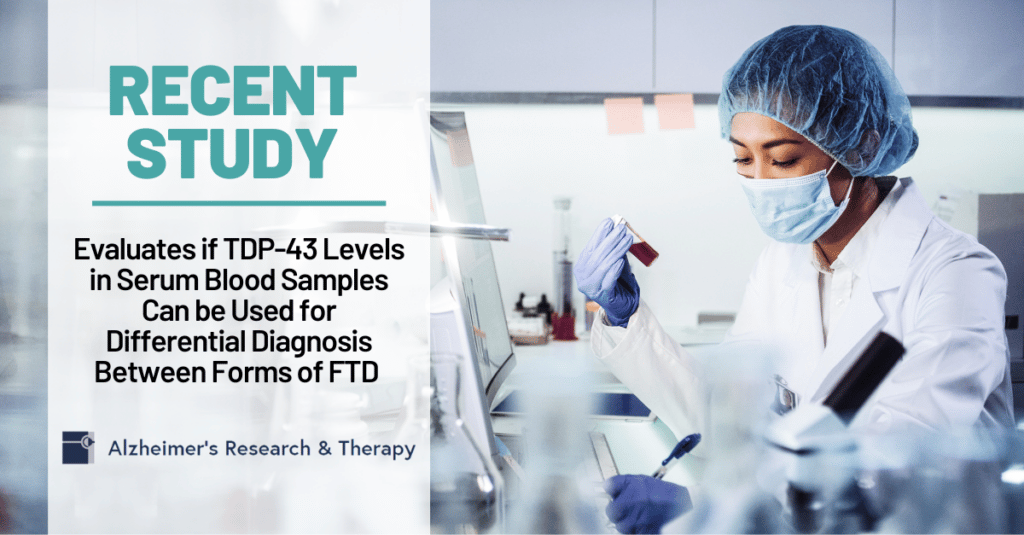Study Evaluates Use of Serum Blood Samples as FTD Diagnostic Tool

In a recent study, researchers evaluated whether measuring TDP-43 in serum samples (blood samples from which certain components, like clotting agents or cells, have been removed) can be used to differentiate people with FTD from healthy controls or distinguish between the different FTD disorders.
One of the more difficult aspects of FTD diagnosis is how symptoms of the various FTD disorders can overlap with each other as well as with other neurodegenerative diseases such as Alzheimer’s or certain psychiatric conditions.
As the researchers point out in their study, the discovery of biomarkers that reflect the subtype of FTD can prove to be a first step towards making differential diagnosis easier. In addition, no method currently exists to distinguish FTD associated with the protein tau from FTD associated with the protein TDP-43. A biomarker specific for TDP-43 is critical to developing treatments for FTD-TDP.
To measure TDP-43 levels, the researchers used a “single-molecule array” (or “Simoa”) assay, which can detect proteins that are present in very low levels, to examine serum samples from people with FTD disorders as well as healthy people with no neurodegenerative disorder. The researchers also hoped to determine whether the sensitive Simoa assay could reliably detect TDP-43 in blood as an alternative to cerebrospinal fluid (CSF), which can only be retrieved through a lumbar puncture.
The study recruited 359 participants through the Kuopio University Hospital Department of Neurology in Finland, and the University of Brescia Centre for Neurodegenerative Diseases in Italy. All the participants were diagnosed using the most up-to-date criteria for each subtype and were divided into different groups based on FTD subtype:
- 125 diagnosed with behavioral variant frontotemporal degeneration (bvFTD)
- 65 diagnosed with nonfluent/agrammatic variant primary progressive aphasia (nfvPPA)
- 33 diagnosed with semantic variant primary progressive aphasia (svPPA)
- 24 diagnosed with progressive supranuclear palsy (PSP)
- 9 diagnosed with FTD with motor neuron disease (FTD-MND)
- 105 without an FTD diagnosis (healthy controls)
The team also wanted to know whether the Simoa assay could distinguish FTD-TDP from FTD-tau. To do this, they looked at the subset of participants with an FTD-associated gene mutation. People with mutations in the progranulin gene or the C9orf72 gene are usually found to have TDP-43 pathology at autopsy, suggesting that changes in serum TDP-43 specific to these individuals be a useful FTD-TDP biomarker during life.
Data from participants were further sorted based on whether their FTD was associated with a gene mutation or tau. One of the brain proteins that forms abnormal accumulations in FTD; approximately 40%25 of people with FTD have FTD-tau. In healthy brain cells, tau stabilizes microtubules that maintain the internal structure of axons., as well as into sporadic and genetic cases.
The study found that TDP-43 levels appeared to be lower in the samples from people with a C90rf72 mutation, while serum TDP-43 in the group with a progranulin mutation and the group with a tau mutation didn’t differ as significantly from the control group. In addition, serum levels of TDP-43 were lower overall for people with FTD compared to levels in the control group. The lowest levels were found in people with FTD and motor neuron disease, while the highest levels were observed in samples from people with PSP.
The study was limited by an inability to compare serum sample levels against the levels of TDP-43 in the brains of participants, with a notable overlap of TDP levels between many participants. Researchers noted that the diagnostic potential of TDP-43 measurements could be improved by comparing serum against samples taken from other parts of the body, in addition to comparing TDP-43 levels against other biomarkers.
Around the world, leaders in FTD research are currently work towards providing better diagnostic tools using biomarkers. To learn more, click here to read about a study evaluating neurofilament light (NfL) as potential biomarker, and click here to read about the use of tau as a diagnostic biomarker.
By Category
Our Newsletters
Stay Informed
Sign up now and stay on top of the latest with our newsletter, event alerts, and more…
